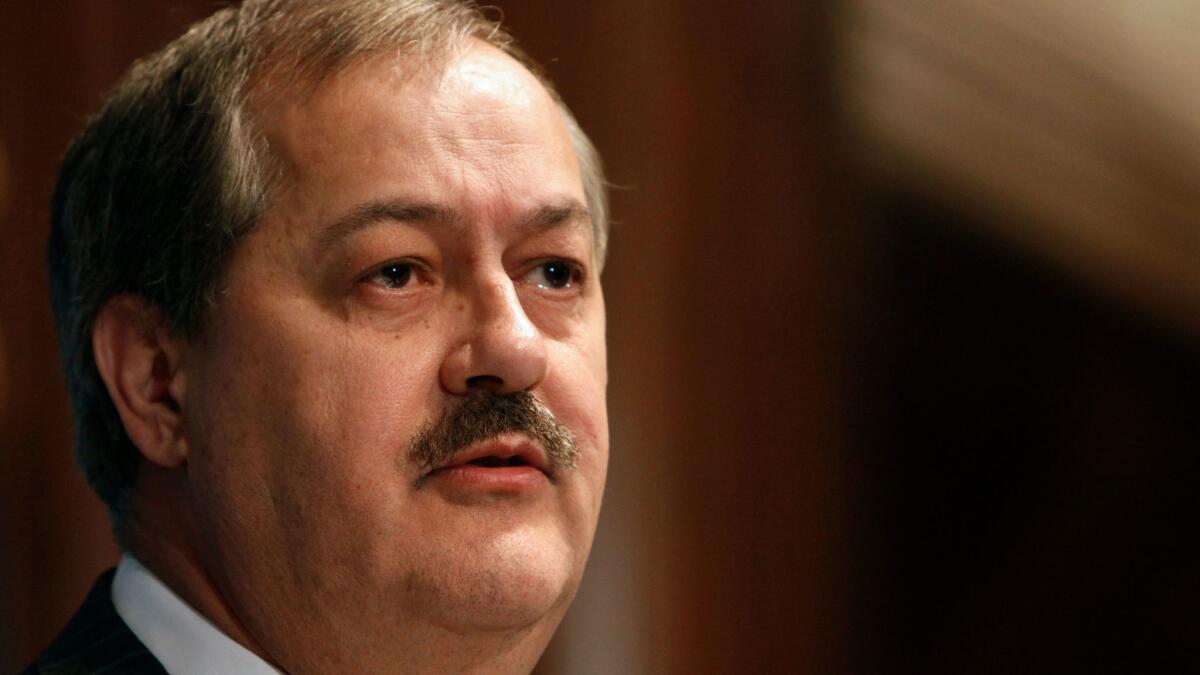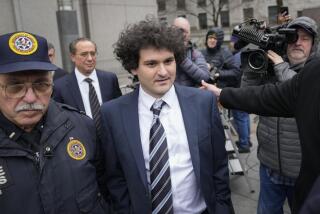Column: A convicted coal executive is still trying to dodge blame for the deaths of 29 miners

- Share via
In the annals of executive chutzpah, one would be hard-pressed to find a more extreme case than Don Blankenship’s efforts to vindicate himself for his role in a huge mine disaster.
Blankenship was chief executive of Massey Energy on April 5, 2010, when an explosion in its Upper Big Branch mine in West Virginia took the lives of 29 men.
Incredibly for an era in which executives skate from blame for their companies’ wrongdoing, and even more amazingly in the coal state of West Virginia, Blankenship was indicted in 2014 for overseeing policies that systematically placed profits ahead of safety. He was convicted by a federal jury in 2015 of a single misdemeanor for conspiring to violate federal mine regulations and sentenced to a year in jail, a term he completed earlier this month.
I have a very special affection for coal miners and, therefore, a great interest in coal miner safety.
— Convicted coal mining executive Don Blankenship
Freshly at liberty, Blankenship has resumed his campaign to portray himself as the victim of a government conspiracy. It’s a remarkable claim, warranting close scrutiny before it’s dismissed as preposterous. Incidentally, aficionados of executive audacity should appreciate that within days of his release from prison, Blankenship wrote wrote to President Trump attesting to his own devotion to the men who were once under his corporate thumb.
“I have a very special affection for coal miners,” Blankenship wrote, “and, therefore, a great interest in coal miner safety.”
He also urged Trump to reject calls for “increasing the criminal liability for coal mine supervisors.” He wrote, “more onerous criminal laws will not improve mine safety.” Coal, he concluded, is what “America needs to be great again.”
The major thrust of Blankenship’s new campaign, according to “an open letter to the public at large” he published Tuesday, is to appeal his conviction to the U.S. Supreme Court, which he says will be launched by his lawyers on Thursday. His chief claims are that the judge at his trial gave erroneous instructions to the jury and that his lawyers were denied the opportunity to cross-examine a prosecution witness. Both assertions were rejected in January by a federal appeals court in Richmond, Va., which found that the jury instructions were valid and that the witness already had been cross-examined once, and a second cross would yield nothing materially new.
Blankenship’s main point, however, is that he’s being mistreated by the system. “When an American convicted of only a non-violent white-collar misdemeanor is incarcerated prior to an appeal,” he writes, “the same basic question should be asked — why?”
This is largely a continuation of a campaign Blankenship began last year with the release of a pamphlet identifying himself as “an American political prisoner.” It doesn’t much resemble the Rev. Martin Luther King Jr.’s Letter from a Birmingham Jail, though Blankenship says his case is “about freedom of speech and the right to a fair trial.” He charges “misconduct by prosecutors, judges, law clerks, and the FBI, as well as Senator Joe Manchin, and the head of the Mine Safety and Health Administration.” Manchin (D-W.Va.) is a former governor of the state.
These are heady claims, so it’s proper to examine the evidence that led to Blankenship’s conviction. Blankenship contends that the explosion was the result of a freak inflow of natural gas; mine regulators blamed inadequate ventilation and accumulations of coal dust.
Testimony at trial depicted him as a relentless micro-manager who received daily reports of mine production and safety violations. These were numerous — 549 at the Upper Big Branch mine in 2009 alone. In the 15 months before the explosion, the appeals court observed, that mine ranked third in the U.S. in the number of “serious safety citations.”
Blankenship’s policy was to “invariably press for more production even at mines that he knew were struggling to keep up with the safety laws,” the court noted. Massey’s approach was to treat safety fines as a cost of doing business. “Repeatedly informed of safety violations at Upper Big Branch … [Blankenship] chose to prioritize production and pay fines rather than take steps necessary to prevent the safety violations from continuing.”
Indeed, the very point of the Nixon era’s Mine Safety Act making mine operators subject to personal criminal liability was to deter them from treating fines as cheaper than safety compliance.
Blankenship wasn’t above throwing his money around to get his way, according to a 2009 ruling by the U.S. Supreme Court. That case stemmed from a lawsuit in which Massey had been ordered to pay $50 million in a contract dispute. While the case was on appeal to the West Virginia Supreme Court, Blankenship bankrolled a $3-million campaign aimed at unseating one of the justices.
Blankenship’s candidate, Brent Benjamin, won narrowly, then refused to recuse himself from the Massey case when it came before him and found in Massey’s favor, voting to overturn the $50-million verdict.
This was all too much for Justice Anthony Kennedy, writing for the U.S. Supreme Court’s 5-4 majority. “The facts now before us are extreme by any measure,” he ruled. “The parties point to no other instance involving judicial campaign contributions that presents a potential for bias comparable to the circumstances in this case.” The Supreme Court kicked the case back to West Virginia, where the judges — this time with Benjamin absent — again ruled in Massey’s favor.
In any event, for all his crabbing about mistreatment and injustice, Blankenship didn’t do so badly. Upon his retirement from Massey a few months after the Upper Big Branch disaster, he was set to receive a pension worth $5.7 million, according to the company’s proxy filing and an analysis by Michelle Leder of footnoted.com. His golden parachute included $27.2 million in a deferred-compensation account and a “salary continuation retirement benefit,” which will keep paying Blankenship $18,241 a month for 10 years after his retirement, along with free housing in a company-owned home.
Keep up to date with Michael Hiltzik. Follow @hiltzikm on Twitter, see his Facebook page, or email michael.hiltzik@latimes.com.
Return to Michael Hiltzik’s blog.
More to Read
Sign up for Essential California
The most important California stories and recommendations in your inbox every morning.
You may occasionally receive promotional content from the Los Angeles Times.













